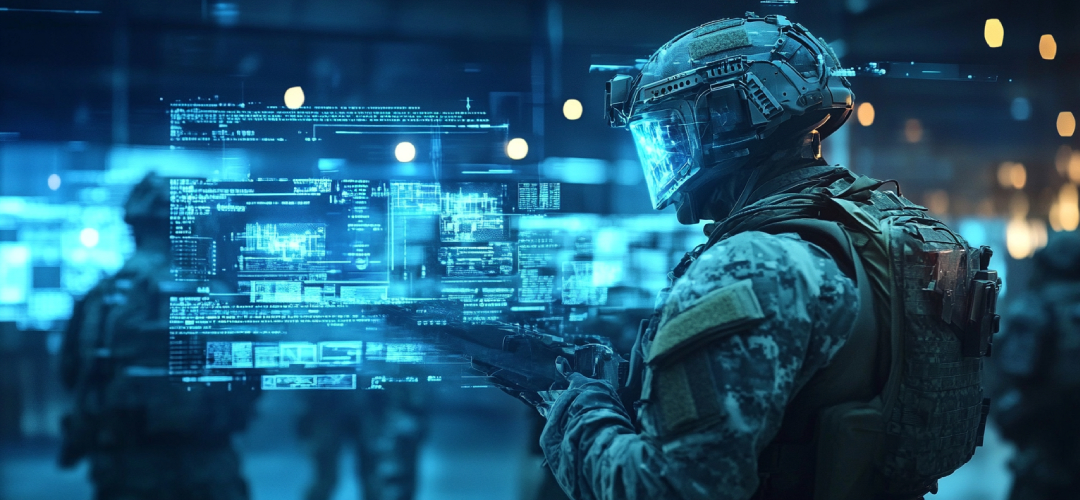Is AI reprogramming warfare?
Does war enhance technology, or does technology enhance war? Well, in this case, it’s a double-edged sword. Rapid AI development is a result of its high demand on the battlefield. Integrating artificial intelligence (AI) into military operations has revolutionised modern warfare, offering advanced capabilities in intelligence analysis, autonomous systems, decision-making, and logistics.
Experts claim that AI enhances operational efficiency, reduces human error, and provides unprecedented strategic advantages. Reportedly, Russia’s AI-driven Armata T-14 tank uses autonomous targeting and navigation systems to identify and prioritise targets, streamlining decision-making in combat with pinpoint precision. However, on the killing fields of Ukraine, it has yet to prove its potential.
The U.S. Defence Advanced Research Projects Agency (DARPA) is exploring AI’s potential through its Squad X Experimentation program, which aims to enhance small unit operations with real-time situational awareness and decision support. This means that AI is getting down to the level of real soldiering!
Background
While seemingly contemporary, the concept of AI in warfare traces its origins to the early applications of computer systems in military operations during World War II, such as code-breaking and ballistic calculations. Over the past decade, swift advancements in AI and machine learning have significantly enhanced AI’s capabilities and applications in warfare.
A prime example is Project Maven, an initiative by the U.S. Department of Defence to integrate AI and ML into military operations. This project leverages AI to analyse drone footage, effectively identifying and classifying objects of interest with unprecedented accuracy. Large data generated from multiple sources—from satellites and drones to sensors—demand advanced tools for effective analysis and interpretation. AI systems, with their capacity to process and analyse data at scales and speeds far beyond human capability, have become indispensable in this context.
China has developed and deployed AI-powered drones, including the CH-7 and Wing Loong series. These drones have sophisticated AI algorithms that enable autonomous reconnaissance, surveillance, and strike missions, demonstrating their efficacy in intelligence gathering and combat operations.
Recent advancements in computational power, sophisticated algorithms, and data storage technologies have rendered the real-time deployment of AI systems feasible and increasingly efficient. These developments enable the seamless integration of AI into operational environments, facilitating enhanced data-driven decision-making and operational agility.
Countries endeavour to harness AI to secure a strategic edge over their adversaries, enhancing offensive and defensive capabilities. The UK’s Ministry of Defence is advancing this objective through Project Minerva, an initiative dedicated to integrating AI into the military decision-making framework. Project Minerva seeks to augment commanders’ decision-making prowess by delivering AI-driven insights and predictive analyses derived from real-time data.
Analysis
There are some spheres of warfighting in which AI has already started showing its effectiveness. One such area is ISR (Intelligence, Surveillance, and Reconnaissance); AI-driven systems excel in rapidly sifting through enormous volumes of data, adeptly identifying patterns and anomalies that may signify potential threats. Advanced image recognition algorithms, for example, can scrutinise satellite or drone imagery to uncover unusual activities or concealed installations, such as unauthorised military build-ups. This enhanced capability accelerates the intelligence cycle and significantly improves situational awareness, empowering military forces to make more informed and precise decisions.
Leveraging machine learning and data analytics, AI systems can predict adversarial movements, evaluate risk levels, and recommend optimal responses, thus providing a strategic advantage in modern warfare’s dynamic and complex environments.
However, what will make an impact on the kinetic battlefield is the appearance of Autonomous Systems in large swarms, including drones and uncrewed ground vehicles. Sophisticated AI algorithms empower these systems to navigate intricate environments, circumvent obstacles, and make real-time decisions with precision. For example, the U.S. military employs AI-enhanced drones for surveillance and precision strikes, enabling operations in difficult conditions while significantly mitigating risks to human soldiers. The advent of autonomous weapons, often termed “killer robots,” ignites critical debates regarding the morality of delegating life-and-death decisions to machines.
Three pivotal factors are propelling the current technological race. Firstly, AI has evolved remarkably, advancing from rudimentary face recognition to sophisticated text and image recognition and high-resolution video production. This rapid progression heightens concerns regarding autonomy and control in warfare, as increased reliance on AI and robotics could exacerbate conflicts and complicate command structures.
Secondly, the high-tech industry’s fascination with AI’s revenue potential is profound. Companies like Google, Microsoft, Apple, Tesla, Meta, Amazon, and Nvidia now constitute 30 per cent of the Fortune 500’s value, with their stocks soaring by 70 per cent on the S&P Index last year. Consequently, industries across the board are crafting AI strategies. Militaries also acknowledge the necessity of heightened AI investments to explore its future warfare applications and are ready to splurge millions on them.
Lastly, there is an increasing awareness of the need for AI regulation. Governments and tech companies recognise AI’s inherent risks to humanity, life, and freedom. Ensuring autonomous weapon systems adhere to International Humanitarian Law and minimising civilian harm are significant challenges. Ideally, AI should mitigate the economic impact of war rather than delegate life-and-death decisions to machines.
AI is pivotal in cybersecurity and electronic warfare, offering enhanced capabilities beyond traditional methods. Advanced AI algorithms are adept at rapidly detecting and mitigating cyber threats, surpassing conventional approaches in speed and efficacy. For instance, machine learning models can discern strange patterns in network traffic, effectively flagging potential cyber-attacks with high precision. Furthermore, AI contributes to developing sophisticated countermeasures against electronic warfare tactics, including jamming and spoofing. By leveraging AI’s analytical prowess, military forces can pre-emptively address vulnerabilities and reinforce defences against evolving electronic threats.
Assessment
- International cooperation and dialogue are imperative for developing norms and regulations that govern the use of AI in military contexts, ensuring these advanced technologies are employed with the utmost responsibility and ethical consideration.
- On the one hand, AI technologies significantly enhance the efficiency, effectiveness, and safety of military engagements. With this technology in use, it’s essential to have a multi-process approval system, as reports of AI being misused on the battlefield are already pouring in.
- Concerns also persist about the reliability and accountability of AI systems, alongside the potential for adversaries to exploit technological vulnerabilities.




